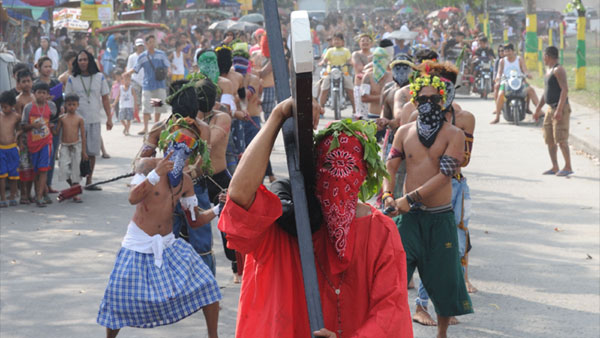Self flagellation is one of the popular practices by the Catholic faithful in the Philippines during Good Friday, along with the crucifixion. It is characterized by the use of a “taktak”, a small wooden paddle with bits of glass or blade that a penitent would whip on his back as part of his atonement for his sins, A “berdugo” or executioner would then pour liquor or rub salt on the penitent’s back to disinfect the self-inflicted wounds. Photos by INQUIRER.net’s Joseph Garibay, AFP, AP. Edited by INQUIRER.net’s Ryan Leagogo
SAN FERNANDO, Philippines—Thousands of people flocked to rural fields in the Philippines on Friday to witness the gruesome spectacle of men being crucified in their annual Easter re-enactment of the death of Jesus Christ.

Penitents flagellate themselves as part of Lenten observance in Angeles City, Pampanga province, north of Manila on April 17, 2014. The dominant Roman Catholic church does not condone flagellation and other extreme acts of penitence including gory Good Friday reenactments of the crucifixion of Jesus Christ, but devout Catholics say it is a means of atoning for their sins and to implore God to spare them and other members of their families from illness or bad luck. AFP
The ritual, held every year to mark Good Friday in Asia’s bastion of Catholicism, has been going on for decades, becoming a major tourist draw despite official disapproval from Church leaders.
Organizers said at least nine men were scheduled to be nailed to wooden crosses this year in farming districts in the city of San Fernando, 65 kilometers (40 miles) north of Manila.
The tradition also includes hundreds of hooded “penitents” flogging themselves with makeshift whips on the sidelines, sometimes accidentally splattering their blood onto onlookers.
Organizers have changed the schedule this year to minimize overcrowding. Instead of having all the crucifixions take place in one district at midday, they will be staggered throughout the day in different parts of San Fernando.
In the first session, three men dressed as Christ took turns having three-inch (7.6-centimeter) stainless steel nails driven through their hands, pinning them to crosses as other villagers — dressed as Roman centurions — looked on.
Penitents flagellate themselves while another carries a wooden cross as part of Lenten observance in Angeles City, Pampanga province, north of Manila on April 17, 2014. The dominant Roman Catholic church does not condone flagellation and other extreme acts of penitence including gory Good Friday reenactments of the crucifixion of Jesus Christ, but devout Catholics say it is a means of atoning for their sins and to implore God to spare them and other members of their families from illness or bad luck. AFP
Two of the men were later carried off on stretchers but another, named Rolly Pantoja, walked off on his own, raising his hands to show they were still bleeding.
Ching Pangilinan, tourism officer of San Fernando, estimated that some 30,000 tourists would attend this year’s event, with at least five percent of them foreigners.
She conceded that the spectacle has been a big revenue-earner for hotels and vendors hawking drinks, food and souvenirs, but she denied that the city government is commercialising the event.
“It’s not a money-making scheme for the city government. Although we are not promoting it as a tourist destination, we cannot stop the influx of people to this district during Holy Week,” she told AFP.
She said San Fernando was spending half a million pesos ($11,300) on extra security and traffic assistance for the event.
The crucifixion volunteers often undergo the ordeal several times over a lifetime as part of a promise to God, made in return for a favour such as the healing of a sick relative or good fortune for the family.
But many foreign onlookers were baffled by the spectacle.
“I don’t know what to think. I’m confused,” said 43-year-old George Olson, a Christian businessman from the United States.
Father Joselito Jopson, an executive secretary of the Catholic Bishops Conference of the Philippines, stressed that the Church does not endorse the practice.
But he added: “These are private expressions of faith. It depends on the faithful. We cannot prohibit them if they want to express their faith in that way.”
RELATED STORIES
Aquino to public: Learn to sacrifice
After quake, makeshift churches welcome pilgrims in Bohol
Are your favorite malls open this Holy Week break?


